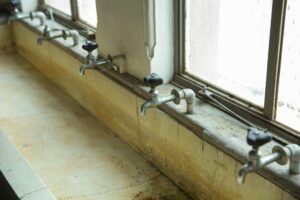The rainy season can be a challenging time for people who suffer from allergies. The increased moisture in the air can promote the growth of mould and mildew, both of which are common triggers for allergies. Prolonged exposure to mould spores, especially among children and people with weakened immune systems, can trigger allergic reactions such as sneezing, coughing, itchy eyes, and skin rashes.
Mould thrives in damp and humid environments, making the rainy season ideal for its growth. Common areas where mould can grow include bathrooms, kitchens, and any surfaces that retain moisture.
Managing these allergens is crucial for maintaining health and comfort during wet weather. It involves a combination of prevention and proactive measures. By controlling indoor humidity, promptly fixing leaks, regularly cleaning damp areas, and using air purifiers, you can significantly reduce the presence of mould and alleviate allergy symptoms during this wet weather. Staying vigilant and informed will help you create a healthier living environment and ensure that wet weather doesn’t dampen your well-being.
Here are some effective strategies to deal with mould and dampness:
1. Control indoor humidity

Maintain indoor humidity levels below 50% to significantly reduce mould growth. Use a dehumidifier to help control moisture levels in your home. Also, ensure good ventilation in moisture-prone areas such as bathrooms and kitchens.
2. Fix leaks promptly

Address any leaks in your home as soon as they occur. Whether it’s a hole in the roof, a burst pipe, or a broken window, fixing leaks promptly can prevent water from accumulating and creating a suitable environment for mould.
3. Clean and dry damp areas
Regularly clean areas that are prone to dampness. Use mould-killing products to clean surfaces in bathrooms, kitchens, and basements. After cleaning, make sure these areas are thoroughly dried to prevent mould from returning.
4. Use air purifiers

Air purifiers with high-efficiency particulate air (HEPA) filters can help remove mould spores from the air. Place air purifiers in rooms where you spend the most time, such as your bedroom and living room, to reduce your exposure to allergens.
5. Regular maintenance of HVAC systems
Ensure your heating, ventilation, and air conditioning (HVAC) systems are well-maintained. Replace filters if and when they are due and consider having your ducts cleaned regularly to prevent mould spores from circulating throughout your home.
6. Monitor indoor plants
While indoor plants can improve air quality, they can also contribute to mould if not properly cared for. Avoid overwatering your plants, and consider using mould-inhibiting treatments on plant soil.
7. Use mould-resistant products
When renovating or repairing areas in your home, consider using mould-resistant products such as paints, drywall, and insulation. These products can help prevent the growth of mould.
READ ALSO: Deep Water: Can Art Solve Nigeria’s Water Crisis?
8. Wear protective gear when cleaning mould

If you need to clean mould yourself, wear protective gear such as gloves, a mask, and goggles to prevent direct exposure to mould spores. Also, ensure the area is well-ventilated during the cleaning process.
9. Seek professional help for severe infestations
For severe mould infestations, it may be best to seek professional help. Consult mould remediation specialists to safely and effectively remove mould and provide solutions to prevent future growth.
10. Stay informed
Stay updated on weather conditions that affect humidity levels and rainfall forecasts, and note how they can impact mould growth. Awareness of high humidity levels and rainfall forecasts can help you take proactive steps to manage dampness in your home.


















